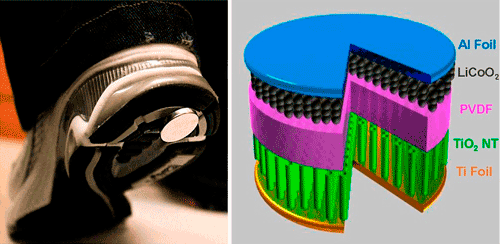Small device harvests, stores, delivers energy
Self-charging power cell has potential to recharge a host of personal electronics in both consumer and military applications
A small, self-contained device that translates mechanical energy into a chemical reaction, and then delivers the energy thus stored as electrical power, has been created by a team of researchers — Xinyu Xue, Sihong Wang, Wenxi Guo, Yan Zhang, and Professor Zhong Lin Wang — from the School of Materials Science and Engineering at the Georgia Institute of Technology in Atlanta. About the size of a U.S. quarter, the device — called a self-charging power cell (SCPS) — has the potential to act as a renewable power source for all types of personal mobile devices, harvesting mechanical energy more efficiently than systems using separate generators and batteries.


Fig. 1: The elements of the self-charging power cell — anode, cathode, and piezoelectric film — are held by Professor Zhong Lin Wang at top. Attached to the heel of a shoe (bottom left), the device can gather mechanical energy due to its chemical composition (bottom right). Professor Wang photo: Gary Meek.
The SCPS uses a piezoelectric membrane to drives lithium ions from one side of the cell to the other when the membrane is deformed by mechanical stress (see Fig. 1 ). The lithium ions driven through the polarized membrane by the piezoelectric potential are directly stored as chemical energy using an electrochemical process.
The cell consists of a cathode made from lithium-cobalt oxide (LiCoO2 ) and an anode consisting of titanium-dioxide (TiO2 ) nanotubes grown atop a titanium film. Separating the two electrodes is a polyvinylidene-fluoride (PVDF) membrane that generates a piezoelectric charge when mechanically compressed. (PVDF film is an ionic conductor for lithium ions, which is why it is used as the binder for electrodes in Li-ion batteries.) The piezoelectric potential works as a charge pump, driving lithium ions from the cathode through the membrane to the anode. The energy is then stored in the anode as lithium-titanium oxide.
When an electrical load is connected between the anode and cathode, electrons flow to the load, and the lithium ions within the cell flow back from the anode side to the cathode side. Compressing the power cell again repeats the cycle.
Using a repetitive compressive force, such as that on the heel of a shoe when a person is walking on pavement, the SCPS generates enough current to power a small calculator. A hybrid power cell the size of a conventional coin battery can power small electronic devices — and could have military applications, allowing troops to recharge battery-powered equipment on the march.
Using a mechanical compressive force with a frequency of 2.3 Hz, the researchers increased the voltage in the power cell from 327 to 395 mV in just four minutes. The device was then discharged back to its original voltage with a current of 1 mA for about two minutes. The team estimates that the power cell’s capacity as currently designed is about 0.036 mA-hr.
So far, the team has built and tested more than 500 cells. Professor Wang believes the generator-storage cell will be as much as five times more efficient at converting mechanical energy to chemical energy for a two-cell generator-storage system. Also, Wang thinks power storage could be boosted with a better case. “The amount of energy actually going into the cell is relatively small at this stage because so much of it is consumed by [deforming] the shell,” he said. “When we improve the packaging materials, we anticipate improving the overall efficiency.”
The research — which is supported by the Defense Advanced Research Projects Agency, the U.S. Air Force, the U.S. Department of Energy, the National Science Foundation, and the Knowledge Innovation Program of the Chinese Academy of Sciences — was originally reported in the journal Nano Letters . For further information, contact Professor Wang at zlwang@gatech.edu
.
Richard Comerford
Advertisement
Learn more about Georgia Institute of Technolog





